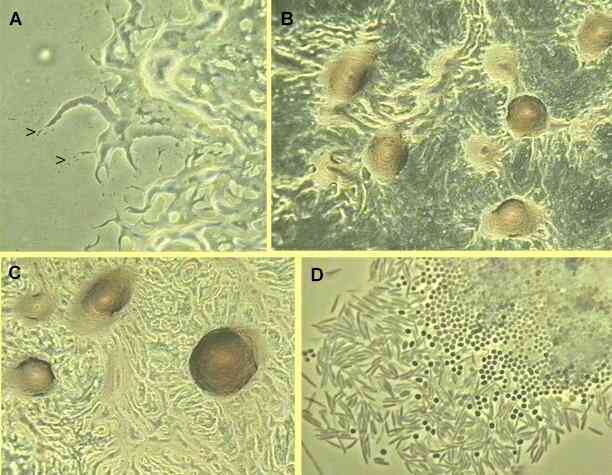This site is no longer maintained and has been left for archival purposes
Text and links may be out of date
 |
A. The edge of a colony of Myxococcus growing on an agar plate, showing slime tracks and a few outlying vegetative cells (arrowheads). B, C. Aggregation of vegetative cells to produce fruiting bodies just behind the colony margin shown in A. Figure B shows clearly that the cells are heaped on top of one another near the bases of the fruiting bodies; most of the slime tracks further away from these points contain few or no cells. D. Part of a small fruiting body crushed by an overlying cover-clip. The elongated vegetative cells (bottom, left) were near the base of the fruiting body, the fully differentiated myxospores dark spherical bodies) were near the apex of the fruiting body, and cells in the centre of the fruiting body (top right) were in different stages of transition into myxospores. |
The gliding mechanism of myxobacteria is poorly understood, but at least in Myxococcus species it seems to be related to the unusual structure of the cell wall. Peptidoglycan is found in only some parts of the wall, and the peptidoglycan patches are apparently held together by lipoprotein material. This could explain why the cells are flexible. Also, it is known that gliding occurs only in the presence of a surface, and the cells often glide against one another in masses rather than individually. Sometimes single bacteria can extend ahead of others at the colony margin, but they soon stop moving unless they are joined by other cells. Myxococcus species are easily cultivated on media containing a mixture of amino acids, which they use as the carbon and energy source; they do not utilise carbohydrates. Unlike some other myxobacteria, Myxococcus species produce simple fruiting bodies in which the stalk is composed of vegetative cells and slime. They also show a clear differentiation of the myxospores, which are spherical, refractile bodies. The myxospores are slightly heat-resistant, but not nearly as much as the endospores of Bacillus species. They resist UV irradiation and desiccation, surviving several years in dry conditions. |
Colony of Myxococcus growing from a central streak on an agar plate containing amino acids. The edge of the colony is marked by arrowheads. Material from this colony was used to produce the images shown above. The mature fruiting bodies give the colony its faint pink colour. |
Further reading: Books and articles M Dworkin and D Kaiser (eds) (1993) Myxobacteria II. American Society for Microbiology. M Dworkin (1996) Recent advances in the social and developmental biology of the myxobacteria. Microbiological Reviews 60, 70-102. Websites: An interesting research site on myxob\cteria, with movies: ~kaiserla at cmgm.stanford.edu |
This site is no longer maintained and has been left for archival purposes
Text and links may be out of date